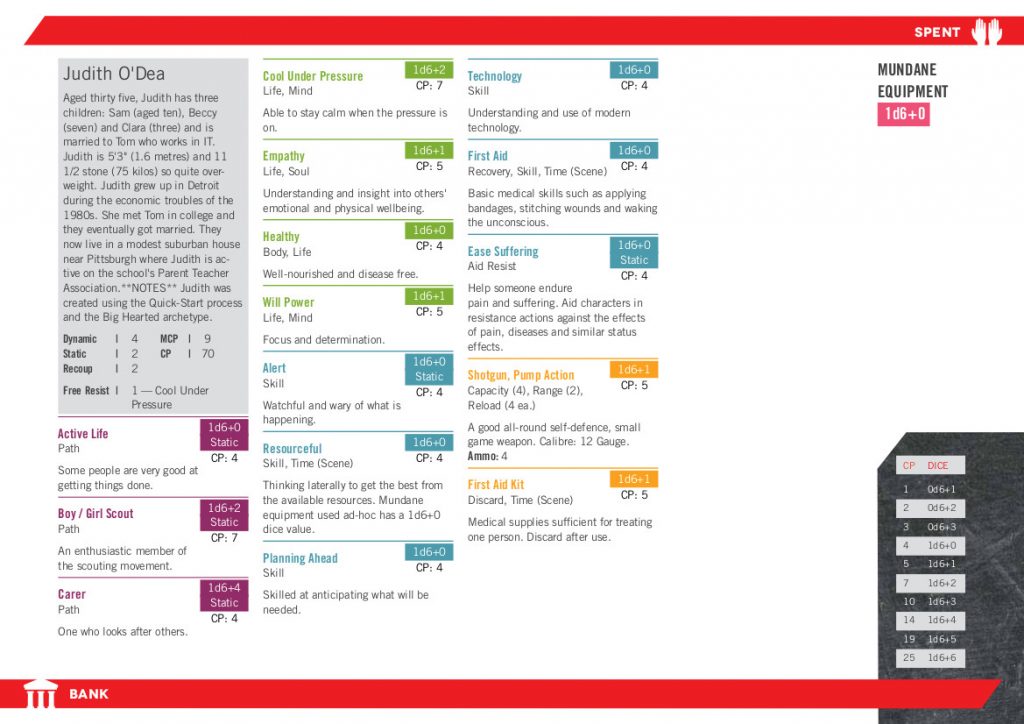Quick character creation depends on character archetypes and character paths, both of which can be found in the Generic / Modern setting and other game worlds. These templates simplify the character creation process and produce a well-balanced, playable character in about ten minutes.
Step 1 – Archetype
Examine the list of archetypes for the setting and pick one.
Step 2 – Character Concept
All characters start with a motif or distinguishing feature. Maybe it’s a particular weapon they use, how they look or speak, their ethical code (or lack of it) or a personality trait such as being pious or affable. This is the starting point of the character and everything else should fit with this idea.
The motif needs fleshing out with details about the character and their back-story. These need to fit with the character’s archetype but most archetypes are flexible and will work with any character background or personality. Each detail is a nugget of information providing role playing opportunities and helps all the players visualise the character. They do not add to any dice rolls and players are largely free to choose what they want but some details may have consequences. Players should seek to answer some of the following details about the character and write them down on the character sheet. The answers are not set in stone and may change as the character concept becomes more refined.
- Name
- Age
- Physical appearance
- Where they live
- Where they grew up
- Their family
- Their occupation
Step 3 – Archetype Paths
Each archetype is made up of two character paths (purple advantages). Write these down in the first column of the character sheet. Also note down that these advantages are static advantages by writing Static or a large S next to the dice value. The archetype will identify one life advantage (green) and two ability advantages (blue) from each of its two paths. Write the life advantages in the second column of the character sheet and the ability advantages in the third. Make note of each advantage’s name, its keywords and any pertinent details from the advantage’s description. If the advantage is static, note this down as well.
Step 4 – Variant
Each archetype has three variants themed about different styles of characters or settings. Each variant adds a life advantage and either two ability advantages, two equipment (yellow) advantages or one of each. Pick the variant and add the advantages to the character sheet. Also note down the variant’s recommendation for the character’s free resist. This will be one of the advantages already added but the name needs to be added to the details section in the top left of the character sheet. This will become important if the character is attacked.
Step 5 – 3rd Path
Next, using the list of character paths included in the game’s setting, pick one additional path. The paths from the archetype will cover the obvious abilities needed for the role, leaving this third path open for players to select something which gives their character some individuality. It should also tie into the character’s back-story and personality. Add the chosen path to the character sheet. From the third path, select a life advantage (green) and two abilities (blue). Do not pick advantages which are already on the character sheet and do try to add diversity to the character’s skills and abilities.
Hint: It is especially useful to add variety to the character’s green life advantages. Before picking one from the third path, look at the keywords on the life advantages already selected. They will be Body, Mind or Soul depending on whether they are physical, mental or metaphysical. Characters with a mix of Body, Mind and Soul keywords are more flexible and can apply them- selves to a wider range of actions.
Custom Builds
To create a character without an archetype, skip Step 1 and then in Step 3 pick three paths instead of one. In Step 4, choose one life and two ability advantages from each path, and remember to pick one advantage which can be used as a Free Resist. Rather than choosing a variant archetype in Step 5, pick either: two ability advantages from any of the chosen paths; one ability and one equipment advantage; or two equipment advantages. All other steps in the creation process are the same.
Step 6 – Add Dice Values
By this step characters will have 15 advantages: three character paths (purple), four life advantages (green), between six and eight ability advantages (blue) and between zero and two character equipment advantages (yellow). All these will be worth at least 1d6+0 when used in actions but some advantages may be worth more.
Pick two advantages and write 1d6+2 as the dice value with a CP value of seven. Then pick four advantages and give them dice values of 1d6+1 and a CP of five. The remaining nine advantages will be 1d6+0 with a CP of four.
Hint: Advantages which are likely to be used often are good candidates for higher dice values, as is the advantage selected for the Free Resist. The green life advantages represent the character’s health and higher dice values allow them to take more damage.
Step 7 – Mundane Equipment
Players should make a note of any significant mundane equipment they have at the start of the game, checking with the Game Leader that they are acceptable. Obvious things like clothes do not need to be written down as a character is always assumed to have everyday, common sense items.
Step 8 – Finishing Off
On the character sheet, there are a few more details to be filled in. These are the same for all characters created using the quick- start process:
- Dynamic Potential: 4
- Static Potential: 2
- Recoup: 2
- MCP: 9
- CP: 70
Notes on Character Creation
The quick-start approach produces characters quickly but it lacks the fine tuning available on the full character creation process. Using the quick-start process creates rounded and realistic characters but they also tend to be less optimised. However, less optimised does not mean worse to play. Game Leaders should encourage players to make interesting characters over perfectly-crafted adventurers and should adjust the difficulty of the challenges to match the party’s abilities.
Example of Character Creation

Step 1
Sally is creating her character for an adventure set in the zombie apocalypse and is using the Generic Modern setting. She wants to play an average person caught up in extraordinary circumstances and picks the Big Hearted archetype.
Step 2
Thinking about her character, Sally decides on a soccer mom – a practical, hard-working person who raises her kids and is active and helpful around the neighbourhood and school. Sally makes a few notes on her character:
Judith O’Dea, aged thirty five. Judith has three children: Sam (aged ten), Beccy (seven) and Clara (three) and is married to Tom who works in I.T. Judith is 5’3″ (1.6 metres) and 11 1/2 stone (75 kilos) so quite overweight. Judith grew up in Detroit during the economic troubles of the 1980s. She met Tom in college and they eventually got married. They now live in a modest suburban house near Pittsburgh where Judith is active on the school’s Parent Teacher Association.
Step 3
The Big Hearted archetype has the Active Life and Carer character paths which Sally notes down on her character sheet. Following her archetype, Sally adds the Cool Under Pressure, Planning Ahead and Technology advantages to her characters. These come from her Active Life path. From her second path, Carer, she adds Empathy, First Aid and Ease Suffering.
Step 4
Sally now has to pick one of the variants for her archetype. The obvious choice is the Zombies! variant and Sally goes for it. Sally adds Judith’s variant life advantage to the character sheet, which is Healthy, and notes down her free resist Cool Under Pressure.
The Zombies! variant has two additional variant advantages, both pieces of character equipment: a First Aid Kit and a Shotgun, Pump Action.
The first aid kit very much fits with Sally the carer, she is certainly the sort of woman who would always have one nearby. The shotgun is harder for Sally to fit with Judith’s soccer mum image.
Sally decides Judith is not a fan of guns but shortly after she had her first child, Tom was working away from home much of the time. Left alone in the house with her child, Judith decided it was up to her to protect her new family. After carefully researching the best guns for home defence, taking lessons in gun safety and installing a child-proof gun cabinet, Judith purchased a pump action shotgun. The gun has never been used except once a year when Judith, Tom and the children go on a firearm safety day to refresh their gun skills. The gun is not a big part of Sally’s life but it is very definitely Sally’s gun.
Step 5
Sally must now pick a third character path but none of the paths suggested by the variant fit with her idea for the character. Instead she picks Boy / Girl Scout, deciding Judith’s experiences in the scout movement were an escape from the rough Detroit neighbourhood of her youth and helped forge the caring, active woman she is today. From her third path, Boy / Girl Scout, Sally picks Will Power, Resourceful and Alert which fit with Judith’s practical and capable personality.
Step 6
Sally now allocates dice values and CP to Judith’s advantages. Cool Under Pressure is a key advantage for Judith. It is her free resist and usable with the shotgun when she wants to take the fight to the zombies. Just as importantly, being unflappable and prepared for any situation is very much Sally’s idea for Judith’s character. So Sally makes Cool Under Pressure one of the two CP 7 / 1d6+2 advantages and decides on the Boy / Girl Scout path for the second one. This advantage will be useful whenever Judith needs to start a fire, follow tracks, navigate and any outdoors type of activity. Sally doesn’t know what the Game Leader has planned but she thinks practical survival abilities will be important.
For Judith’s four CP 5 / 1d6+1 advantages, Sally picks: First Aid Kit; Shotgun, Pump Action; Empathy; and Will Power. It makes sense to Sally to improve the shotgun and medical kit as they are likely to be used a lot. Empathy is a good advantage for social situations and Judith is weak in this area. Will Power is chosen partly because it fits with the character but also because both Empathy and Will Power are life advantages. Increasing these advantages lets Judith take a little bit more damage in a fight.
Step 7
Discussing mundane equipment with the Game Leader, Sally decides there is very little that needs to be written down. Judith has a house full of everyday things but nothing unusual or important. The one thing Sally does write down is Judith’s Car, a large seven-person people carrier, because Sally can see having a large car being useful when the zombies attack.
Step 8
Sally tidies up her character sheet, adding the values for Dynamic Potential, Static Potential, Recoup, MCP and CP. On the back of the sheet Sally adds a few biographical and background notes about Judith.

